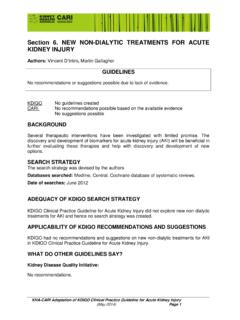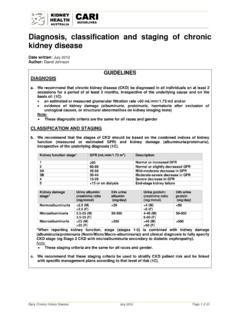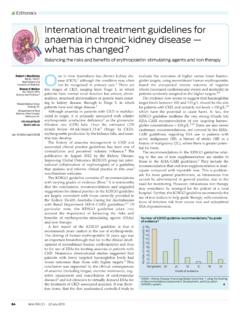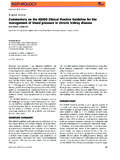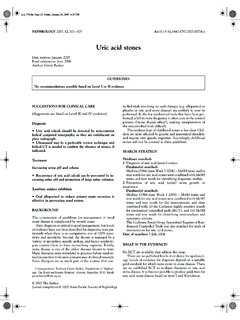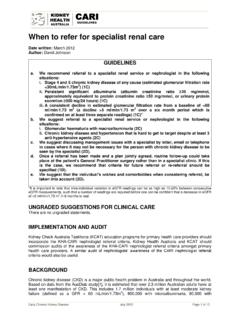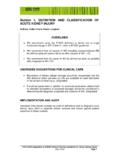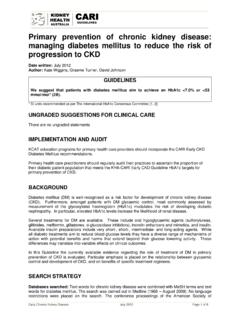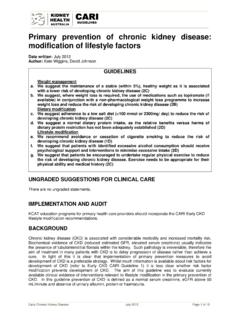Transcription of Nursing care of arteriovenous fistula / arteriovenous graft
1 Nursing care of arteriovenous fistula /. arteriovenous graft Date written: November 2011. Author: Edwina Vale, Pamela Lopez-Vargas, Kevan Polkinghorne GUIDELINES. a. Skin at the intended cannulation site should be prepared with an alcohol based solution (Level II evidence). b. cannulation should be undertaken using a clean or aseptic' technique (Level II evidence). c. Compared to the rope ladder technique , button-hole technique is associated with an increased risk of local and systemic infection and should not be routinely performed. (Level II evidence). SUGGESTIONS FOR CLINICAL CARE. (Suggestions are based on Level III and IV evidence). It is suggested that assessment of the arteriovenous fistula / arteriovenous graft be undertaken each time prior to cannulation .
2 Patency should be checked for adequate bruit and thrill, and the site inspected for signs of infection. (Level III evidence). Rope ladder technique is suggested for cannulation of arteriovenous fistulae and grafts. Button-hole technique maybe useful for patients with significantly reduced cannulation area of the arteriovenous fistula after discussion of the potential benefits and harms. (Level III. evidence). We suggest strict adherence to infection control procedures be undertaken to minimise infection risk when using button hole technique for cannulation . (Level III evidence). Patients should be instructed on the care of the arteriovenous fistula / arteriovenous graft between cannulation sessions in particular: (Level III evidence).
3 Vein preservation: avoidance of cannulation in the effected limb How to check for patency: clinical monitoring of bruit and thrill Observing the site for signs of infection The importance of identifying and reporting problems with vascular access Adherence to good personal hygiene Observe for signs of steal syndrome: hand going pale/blue, cold, with/out pain IMPLEMENTATION AND AUDIT. Conduct annual auditing of Staphylococcus aureus bacteraemia rates. Data for Methycillin Resistant Staphylococcus Aureus (MRSA), Vancomycin Resistant Enterococcus (VRE) and Extended Spectrum Beta-Lactamase (ESBL) should be included. Rupture of vascular access ( fistula and graft ), and complication rates of all vascular accesses within the unit should be recorded and reviewed regularly.
4 Accredited staff training and education in infection control needs to be a mandatory requirement for all staff working with vascular access patients. Strict adherence to infection control policy must be promoted and evaluated regularly within the unit. _____. Vascular Access July 2012 Page 1 of 23. Accredited ongoing staff training and education in cannulation technique should be undertaken by all staff accessing arteriovenous fistulae or grafts. BACKGROUND. An effective haemodialysis treatment is dependent on a well-functioning vascular access which has good blood flow, excellent patency, and allows easy and repetitive cannulation with two needles. The arteriovenous fistula (AVF) provides the best access for longevity and lowest association with morbidity and mortality, followed by arteriovenous grafts (AVG s)[1].
5 Complications due to vascular access represent a large number of inpatient hospitalisations, and are an important cause of morbidity and mortality for the dialysis population. In a 1993 review of the United States Renal Data Service database, 15-16% of hospitalisations were vascular access related [2]. Thrombosis, stenosis, and infection are the three most prevalent complications of arteriovenous fistulas and grafts increasing reliance on central vascular catheters for dialysis access [3]. Patients dialyzing with AVG s or central venous catheters (CVC s) have a significantly higher relative risk for death, and in diabetics, AVG s and CVC s were associated with a higher overall relative risk of death of and respectively, when compared to AVF[4], Mortality is reduced by approximately 50% in patients who switch from a catheter to a permanent access ( fistula or graft ) as compared with those who remain catheter dependent[5].
6 Patients with central venous catheters in use for haemodialysis have a higher mortality risk, followed by those with an arteriovenous graft and then arteriovenous fistula , thus preservation of the dialysis patients arteriovenous fistula or graft is critical to improved survival [4]. Infection remains one of the greatest risk factors to morbidity and mortality for the dialysis population. The ANZDATA report summary [6] has reported 11% of all deaths in the dialysis dependent population in 2010 were due to infection. The Canadian Morbidity Study showed a rate for AVF infection and a for AVG infection in the first year of follow up [2]. Infection remains second only to cardiovascular death as a cause of mortality accounting for 15-20% of patient death [2].
7 In addition, infections are the leading cause of all hospital admissions (102 admissions / 1,000 patient-years) in haemodialysis patients [7]. Staphylococcus aureus carriage in the nose and on the skin has been shown to be more common in patients receiving chronic haemodialysis than in the general population, and has also been found to be a major pathogen in this population, especially as the causative agent of access site infections [8]. Although fistulas require far fewer interventions than do grafts, they still develop stenosis and thrombosis [5]. cannulation techniques, through tissue displacement and repair, may induce the formation of aneurysms and scars that in turn may favour the development of stenotic lesions and impact on fistula and graft survival [9].
8 The two major causes of thrombosis are: (a) damage to vessel wall and endothelium due to continuous cannulation and (b) stenosis, a narrowing of the vessel wall predominantly caused by intimal hyperplasia [10] Thrombosis accounts for approximately 80% of graft failures. Thrombosed grafts usually have an underlying stenosis, and timely detection and correction of the stenosis will prevent graft thrombosis [5]. Needle infiltration of new fistulas is a relatively frequent complication, which occurs most commonly in older patients. A single major infiltration prolongs catheter dependence by a median of 3 months [5]. Good cannulation technique can reduce the incidence of needle infiltration. Repeated cannulation of AVF s and in particular AVG s places the patient at risk for infection via bacterial contamination.
9 Bacteria can either be directly introduced into the circulation leading to either local infection of the access or bacteraemia [2]. Strict adherence to infection control policies is paramount to preventing access site infections. Good cannulation technique , examination of the fistula or graft , and implementing proven infection control practices are essential to minimizing risk factors which compromise an efficient vascular access. Patient education on monitoring the site and prompt reporting of any changes, and adherence to good hygiene, are crucial in preventing AVF/AVG failure. _____. Vascular Access July 2012 Page 2 of 23. This guideline will examine the Nursing care of arteriovenous fistulas and grafts and provide evidence- based recommendations for Nursing care of haemodialysis vascular access.
10 SEARCH STRATEGY. Databases searched: MeSH terms and text words for arteriovenous fistulas and grafts were combined with MeSH terms and text words for retrograde and antegrade cannulation , rope ladder, buttonhole, bevel, and cannula, and combined with MeSH terms and text words for chlorhexidine, anti-infective agents, and cannulation technique , and then combined with Cochrane highly sensitive search strategy for randomised controlled trials as well as other study types such as prospective and retrospective cohort studies. MeSH terms and text words for renal dialysis, hemofiltration, dialysis and end-stage renal disease were also added to the search to identify haemodialysis specific publications. The search was carried out in Medline (1948 to November 2011).
